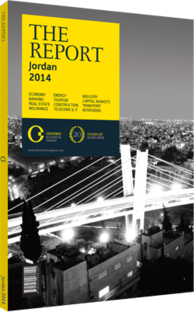Bank of Jordan: Banking
The Company
Established in 1960 in Jordan, the Bank of Jordan (BOJX) has evolved into a key player in the Jordanian banking sector. The bank is a medium-sized institution with 67 branches in Jordan, 14 in Palestine, and a subsidiary in Syria.
In the Jordanian market, the BOJX accounts for 4.2% of customer deposits and 5.1% of credit facilities. The bank’s market share is considerably higher in the Palestinian Territories, where it holds a 10.9% share of deposits and 7.7% of loans. Finally, in Syria, the BOJX has claimed 4% of deposits and 6.8% of credit facilities from private banks.
Although the BOJX does have a regional presence, the Jordanian market generated 85% of the bank’s total revenues in 2013. The BOJX focuses predominantly on the corporate segment with corporate clients comprising 42% of the bank’s loan portfolio. It is worth noting that the corporate segment generated JD37m ($52.3m) in revenues, 31% of the BOJX’s total interest income.
For 2013 the bank disbursed JD40.7m ($57.5m) to shareholders, an increase of 12.3% over the previous year, which translated to a basic earnings per share of JD0.263 ($0.37). Additionally, shareholders’ equity of the bank increased by JD40.5m ($57.2m), an increase of 14.6%, to reach JD317m ($447.8m).
Low-Cost Funding Base
The BOJX’s deposit mix is skewed towards the low-cost current and savings accounts, which constituted around 65% of the bank’s deposits as of the end of 2013, when total deposits stood at JD1.5bn ($2.18bn). The bank’s cost of funds was at around 2% at the end of 2013.
The capital adequacy ratio remained strong, dropping slightly to 16.30% in 2013, compared to 16.46% the previous year. This continues to be well above the 12% required by the Central Bank of Jordan and the 8% indicated in the Basel II guidelines.
Credit Metrics
Despite a 12-basis-point improvement in the non-performing loan ratio to 9.8% at the end of 2013, the bank’s credit metrics remain weak compared to other Jordanian banks. This was mainly attributed to the bank’s significant exposure to the high risk mortgage and corporate sectors. However, the majority of mortgage loans and many corporate loans are collateralised, which leaves ample room for recovery in the foreseeable future. In addition to the drop in NPLs, the coverage ratio (after deducting interest in suspense) rose to 93% for 2013 compared with 83% for the previous year.
Emphasis On The Retail Sector
The economic slowdown in Jordan, side-by-side with the accumulating NPLs in the corporate segment, has pushed the bank towards more emphasis on the retail sector. In 2013 retail loans accounted for 22% of the bank’s total facilities, as compared to 18% in 2010. This shift towards the retail sector is expected to improve the bank’s credit quality.
Improving Economic Conditions
Economic growth is expected to accelerate to 3.5% in 2014 up from 2.8% in 2013 for a number of reasons. Expansionary monetary policy implemented by the monetary authorities has culminated recently in a 50-basis-point cut to the policy rate, while public spending is also on the rise. Meanwhile, the influx of Syrian refugees is likely to increase related economic activity. These factors combined should enhance economic growth and stimulate borrowing.
Risks
Although the BOJX operates in two areas that have recently experienced violent conflict – Syria and the Palestinian Territories – these risks have been largely mitigated. The BOJX has only a limited presence in Syria, while risks from the recent conflict in Gaza Strip are negligible, as the bank mainly operates in the West Bank. In addition, the bank would be subject to regulatory risk emanating from the new income tax law draft. Under the proposed law, banks would be subject to a 35% tax rate compared to the 30% under the current law. Going forward, the BOJX’s risk management operations continue to monitor for internal and external potential risks.
You have reached the limit of premium articles you can view for free.
Choose from the options below to purchase print or digital editions of our Reports. You can also purchase a website subscription giving you unlimited access to all of our Reports online for 12 months.
If you have already purchased this Report or have a website subscription, please login to continue.

